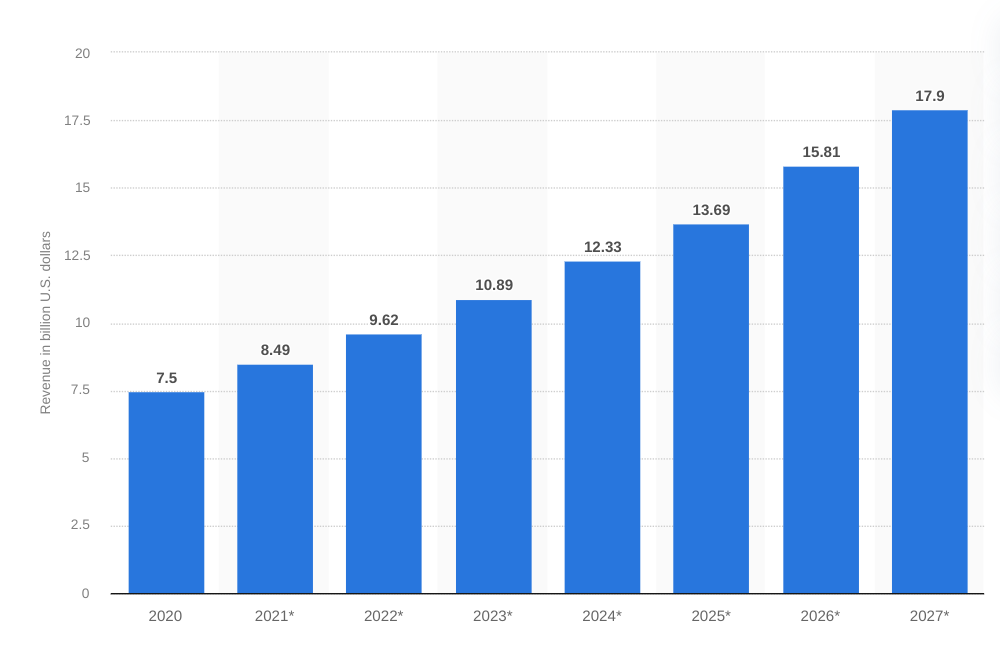Spam-Proof Your Email Marketing: 5 Best Practices
Email marketing is an essential strategy for expanding one’s business.
Besides social media platforms, it is best to include other techniques to create brand awareness for the business. Contacting leads through email marketing is one of the quickest and most effective ways to turn them into leads.
How?
It is possible through direct communication with the target audience, producing high ROI, segmentation and personalization, performance tracking, and integration with other marketing strategies.

According to Statista, email marketing revenue is targeted to accumulate $11 billion by the end of 2023.
But what hinders email marketing’s success? Spam filters.
Spam filters are automated systems that sort authentic communications from unwanted or unsolicited emails. Even though their main job is to keep people from getting harmful or irrelevant content, they can complicate things for real email marketers.
Anyone using email marketing must be aware of spam filters’ extensive effects on email deliverability.
Below are the challenges of spam filters and how they impact email deliverability:
- Decreased deliverability rates
- Loss of revenue
- Content restrictions
- Reputation damage
- Technical hurdles
- Feedback loops and complaint rates
- Crucial engagement
- Frequent list cleaning
- Legislation compliance
This blog will teach us more about the best practices for creating spam-proof email marketing that will scale your business.
Let’s dive in.
Best Practice #1: Be Mindful of Your Sending Frequency Timing
Timing is everything, as they say.
In fact, it is accurate and applicable, especially in email marketing.
In email marketing, it’s essential to be aware of how often and when you send emails so that your subscribers stay interested and your emails don’t get marked as spam.
Here are some key aspects to consider:
Understand your audience’s preferences
Location: Think about where your audience lives in terms of time zones. If your list is global, divide it by time zone to ensure that your emails get to the right people at the right time in their own country.
Behavior of the Audience: Some audiences may like getting texts in the morning, while others may be more interested in them in the evening. Figure out these trends with the help of analytics.
Establish a consistent schedule
Regular times: Sending emails on a regular basis, like every day, every week, every two weeks, or every month, tells your audience what to expect.
Choose quality over quantity: It’s better to send a few high-quality letters than many less-important ones simultaneously.
Test and optimize send times
A/B testing: Test two or more versions of your email on different days and times to see which ones get the most opens and clicks.
Adapt to changes: Be ready to change your plan if seasonal trends, changes in your audience’s lifestyle, or changes in how the market works affect it.
Best Practice #2: Craft Clear, Non-Spammy Subject Lines
Pro tip: you can use an email subject line generator to be sure you craft the best subject line for your purpose.
Creating a subject line for an email plays a pivotal role in email deliverability for numerous reasons. The subject line is particularly critical besides the content, which is the main factor influencing credibility.
According to statistics, when subject lines are unique, open rates go up by a massive 50%, and the average number of opens goes up by 22% when the subject line says “urgent.”
Here are some of the main reasons why it is essential to craft clear and non-spammy subject lines:
First Impression Matters
One of the first things many people see in an email is the subject line. Many times, an interesting subject line is all that separates an email from being ignored. Conversely, a poorly written subject line could make someone more likely to mark the email as spam.
Spam Filter Criteria
Email service providers (ESPs) use spam filters to get rid of emails that are not wanted. These filters frequently look at subject lines. Some words, phrases, or things that look like spam, like using too many capital letters, exclamation points, or other marks, can set off these filters and send the email to the junk or spam folder.
Relevance and Personalization
Subject lines that are relevant to the recipient and seem personal can open more emails. ESPs keep an eye on metrics for engagement. If someone consistently opens and interacts with an email, the ESP may think that emails from that sender are more likely to be authentic and not spam.
Common Spammy Words to Avoid
Below is a list of common spammy words to avoid, listed accordingly:

Tips for Writing Engaging and Clear Subject Lines
Improving your email open rates requires writing subject lines that are both interesting and easy to understand. A well-written subject line gets the reader’s attention, gives them something of value, and sets the tone for the rest of the email.
Here are some tips to follow:
- Keep it short and sweet
- Use action-oriented verbs
- Create urgency (but don’t overdo it)
- Personalize when possible
- Avoid spammy words
- Avoid all caps
- Be clear and direct
Best Practice #3: Maintain a Healthy Email List
For email marketing to work best, you must ensure your email list is healthy. Higher open rates, click-through rates, and overall engagement are all results of ensuring your messages get to engaged and interested people. This is something graduates with business and marketing degree learn during their studies.
Here are some critical steps on how to maintain a robust email list:
Regularly Clean and Segment Your List
When cleaning your email list, you can do it differently, like removing duplicate emails, correcting obvious typos (gamil.com instead of gmail.com), and deleting bounced email addresses.
If you want to segment them, you can do it by grouping subscribers according to their demographics, behavior, or purchase history. Personalizing content to cater to each segment’s needs and interests is also possible.
Provide value and respect preferences
Ensure that the people who sign up for your emails get valuable things from them, like helpful information, special deals, or fun things to read.
Respect your choice of frequency: Don’t send too many emails to your followers; this can make them want to unsubscribe more often.
Properly handle bounces
Quickly get rid of or fix email addresses that “hard bounce,” which means they fail permanently, like a fake address. Watch out for “soft bounces,” which are brief problems like a full mailbox; if they happen a lot, you might want to eliminate them.
Best Practice #4: Pay Attention to Your Email Content and Design
Besides the email content, the copy matters too. You can avoid sending it directly to the spam folder by considering these things:
Avoid Spam-Triggering Words and Phrases
Your email’s subject line and body determine whether it goes to the inbox or the dreaded spam folder. One crucial thing spam filters do when they filter content is look for certain words or phrases often found in spam messages.
You can refer to the common spammy words to avoid mentioned above for reference.
Importance of a Balanced Image-to-Text Ratio and Properly Formatted Emails
Ensuring your email campaigns have a good balance of images to text is not just for looks; it is a key part of ensuring that they get delivered, engage readers, and are easy for everyone to access.
A good ratio of images to text is not just a design choice; it is also a strategic choice that affects how well the campaign delivers, how accessible it is, how engaged people are with it, and how successful it is overall.
Incorporating engaging visuals, such as image to video elements, can enhance email interactivity while still maintaining a balanced image-to-text ratio. These dynamic visuals should be used thoughtfully to support your message without overwhelming the content or triggering spam filters.
Never forget to ensure its mobile optimization for a more responsive design and faster loading time.
Importance of Including a Clear and Easy-To-Find Unsubscribe Link
You must put an unsubscribe link in your emails because it shows that you respect your subscribers and want to communicate honestly.
Putting user preferences and feedback at the top can help email campaigns work better and build stronger customer relationships.
Best Practice #5: Monitor Your Sending Reputation
Another important metric that affects deliverability is the “Sender Score.” Let us learn more about this critical metric and what it means.
But first, let us define what a Sender Score is.
Sender Score is a rate between 0 and 100 that tells you how trustworthy the IP address of an email sender is. When it comes to getting your email delivered, it is like a credit score.
When it comes to email marketing, it poses different impacts:
- Email Deliverability
If the Sender Score is high, ISPs are likelier to deliver emails to the recipients’ inboxes. Your emails might go to the spam folder or be blocked if you get a low score.
- Engagement Rates
More people are likely to open, read, and act on emails in their inbox, making them more likely to be engaged.
- ROI on Email Campaigns
When deliverability and engagement go up, email marketing campaigns will get a better return on their investment.
- Brand Reputation
Sending emails that go to the spam folder can hurt a brand’s reputation with its subscribers.
Importance of Consistent Sending Frequencies and Volumes
Consistency in sending times and amounts is not just a matter of convenience; it is also a strategic decision that affects how people see your brand, how much they trust you, and how well your email marketing campaigns work overall.
Businesses can make the most of their email outreach for maximum impact and engagement by understanding its importance and following best practices.
It is essential for various reasons, such as:
- Predictability
- Trust Building
- Avoiding Fatigue
- Easier Tracking
- Performance Benchmarking
- Respecting the Subscriber’s Choice
- Consistent Brand Voice
- Top-of-Mind Awareness
Reduce Spam in Your Email Marketing With These Five Best Practices
Spam-proofing is not just a technical need; it is an integral part of email marketing that directly affects a campaign’s performance. Businesses can deal with the challenges of digital communication and make sure their messages reach the right people by understanding and stressing how important it is.Apply these best practices to make the most of your email marketing strategies and increase your brand’s reputation.


